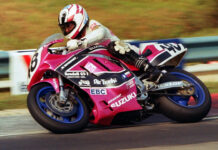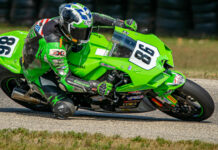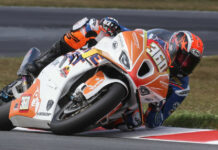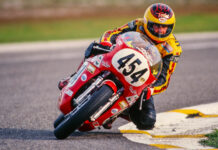Bridgestone MotoGP Preview – Round 9: Germany, Sachsenring Tuesday 12 July 2011 Bridgestone slick compounds available: Front: Hard, Extra Hard. Rear (asymmetric): Medium, Hard After a week’s break since the Italian Grand Prix, MotoGP gets underway again in Germany on 17 July with the first of a back-to-back pairing of races that marks the end of the busiest period of the season with six races in eight weeks. At the start of the year when tyre compound selections were first made, Bridgestone took the decision to bring softer rear slick tyres to the German Grand Prix this season, utilising the extra soft compound rubber developed at the end of last year in a bid to maximise warm-up performance. The Sachsenring circuit has an anti-clockwise layout which means that for this race the left shoulders of the rear tyres need to be harder to cope with the temperature and wear, and it is the right shoulders that need to be softer. The East German venue is a peculiar one for tyres however. It is a short lap, the second shortest of the season only 60metres longer than Laguna Seca, and the weather is unstable meaning it can become overcast and cool down quite quickly, but it is very severe on the left side of the tyres. The flowing nature means that corner speed is high, and on the abrasive tarmac front tyre wear can be high so for the first time since the opening round in Qatar, the extra hard compound front slicks have been selected. In fact, for the left side of the front tyres Sachsenring is the most severe test of the season. Front slick tyre compound options remained unchanged from last year. Rear slicks are now available in medium and hard asymmetric compounds this season, one step softer than last year. Both options use the extra soft compound in the right shoulders, and are a special construction developed for Sachsenring and Philip Island specifically to cope with the high tyre temperature developed by a few corners. It is particularly the string of interlinked lefts from turn six to ten and the fast final two corners that generate the highest temperature. Last year’s German Grand Prix was run in two parts after a red flag caused by a crash involving Randy de Puniet, Aleix Espargaró and Ãlvaro Bautista. Dani Pedrosa took his second victory of the season, ahead of Jorge Lorenzo and Casey Stoner in third. Hiroshi Yamada Manager, Bridgestone Motorsport Department “We saw a brilliant race last time out in Italy that was very exciting for the fans too, so I hope for a similar race in Germany! Dani, Valentino and Casey have each won in Germany in the last three years, each with a different manufacturer, so I hope this is a good sign that we may have a different winner again this year. Having spoken at length to the riders and teams recently we have confirmed that we will change our tyre allocation to bring softer spec tyres to four of the remaining races, but we had already decided at the start of the year to bring softer rears to Germany as part of our continuous assessment of compound selections, so I hope they are well received.” Hirohide Hamashima Assistant to Director, Motorsport Tyre Development Division “Sachsenring is a challenging balance for tyres because the circuit is very severe on the left side of the tyres, where we see some of the highest temperatures of the season, but by contrast the right shoulders of the tyres have a relatively easy time. This means that we need great heat and wear resistance from hard compounds on the left side with soft compounds in the right side for good warm-up. In fact, we have a special construction of slick tyre that we use just in Germany and at Philip Island to deal with tyre temperature. Having said this, this year we are bringing softer rear slicks to Germany as using our special construction we can achieve sufficient heat resistance whilst using a softer compounds than normal to maximise warm-up and tyre performance on what is otherwise quite a low ambient temperature race. “Sachsenring starts with two slow right-hand corners but then opens into a series of very high speed long lefts that sweep onto the back straight and to the finish, generating a lot of temperature in the left shoulder of the tyres. The tarmac is abrasive too, and because of the loads on the left side of the front tyres we have selected our hard and extra hard compound options for good wear resistance and stability. If the bike, rider and tyre package is not working well, it is easy to overheat the left side of the tyres, particularly in the rear.”
Bridgestone Bringing Softer Rear Slicks To German Grand Prix
Bridgestone Bringing Softer Rear Slicks To German Grand Prix
© 2011, Roadracing World Publishing, Inc.






